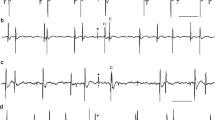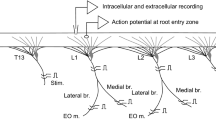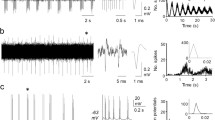Summary
In decorticate, unanaesthetized and curarized rabbit preparations displaying spontaneous fictive locomotor sequences, the firing pattern of neurones was recorded extracellularly in the L6-S1 spinal cord. These neurones, located in the intermediate part of the cord, were not invaded by antidromic stimulation of the hindlimb muscle nerves and thus were considered as interneurones (or propriospinal or tract cells ascending to the brain). When compared to the output from the ipsilateral muscle nerves, these neurones were classified as flexor (F INs) or extensor (E INs) according to the phase of the locomotor cycle when they displayed their maximal firing rate. Among 69 F INs, 33 maintained tonic firing during the periods between episodes of locomotor activity. Their maximal firing rate was in phase with the flexor efferent bursts of the locomotor sequence; during the extensor phase, they maintained an instantaneous frequency (i.f.) that was clearly above the resting i.f. Of these neurones, six became completely silent during the initial flexor-extensor coactivation that opened the sequence (F1 neurones) whereas the 27 others increased their firing rate at that time (F2 neurones). The other neurones (36 F3) were silent between the locomotor episodes. Although most of them had a rhythmic activity limited to the flexor bursts, some fired throughout the locomotor sequence with a maximal rate during flexor bursts. All the 123 E neurones completely stopped firing during the flexor phase. As was the case for F3- neurone firing, E3 neurone firing (34 neurones) occurred only during periods of locomotor activity. Among the neurones that displayed tonic activity between locomotor episodes, the E2 neurones (24 from 123) remained at this resting value during the extensor phase whereas the E1 neurones (65 neurones) showed an increased i.f. for all or part of this phase. These data, which suggest an asymmetrical genesis of the flexor and extensor activities in locomotion, need to be supported by further analysis.
Similar content being viewed by others
References
Baev KV, Degtyarenko AM, Zavadskaya TV, Kostyuk PG (1979) Activity of lumbar interneurons during fictitious locomotion in thalamic cats. Neurofiziologiya 11: 244–250
Brown TG (1911) The intrinsic factors in the act of progression in the mammal. Proc R Soc (Lond) 84: 308–319
Buser P, Viala G (1968) Analyse du mécanisme de l' akinésie induite “hypnotique” chez le lapin. Actual Neurophysiol 8: 179–196
Edgerton VR, Grillner S, Sjostrom A, Zangger P (1976) Central generation of locomotion in vertebrates. In: Herman RM, Grillner S, Stein PSG, Stuart D (eds) Neural control of locomotion, Vol 18. Plenum, New York, pp 439–464
Feldman AG, Orlovsky GN (1975) Activity of interneurones mediating reciprocal Ia inhibition during locomotion. Brain Res 84: 181–194
Fu TC, Jankovska E, Lundberg A (1975) Reciprocal Ia inhibition during the late reflexes evoked from the flexor reflex afferents after DOPA. Brain Res 85: 99–102
Grillner S (1981) Control of locomotion in bipeds, tetrapods and fish. In: Brookhart JM, Mountcastle VB (eds) The nervous system. Handbook of physiology. Motor control, Part 2. Waverly Press, Baltimore, pp 1179–1236
Jankowska E, Jukes MGM, Lund S, Lundberg A (1967) The effect of DOPA on the spinal cord. 6 Half-centre organization of interneurones transmiting effects from the flexor reflex afferents. Acta Physiol Scand 70: 389–402
McCrea DA, Pratt CA, Jordan LM (1977) Renshaw cell activity and recurrent effects on motoneurones during fictive locomotion. J Neurophysiol 44: 475–488
Nelson JR (1959) Single unit activity in medullary respiratory centers of cat. J Neurophysiol 22: 590–598
Noga BR, Shefchyk SJ, Jamal J, Jordan LM (1987) The role of Renshaw cells in locomotion: antagonism of their excitation from motor axon collaterals with intravenous mecamylamine. Exp Brain Res 66: 99–105
Orsal D, Perret C, Cabelguen JM (1986) Evidence of rhythmic inhibitory synaptic influences in hindlimb motoneurones during fictive locomotion in the thalamic cat. Exp Brain Res 64: 217–224
Pearson KG, Duysens J (1976) Function of segmental reflexes in the control of stepping in cockroaches and cats. In: Herman RM, Grillner S, Stein P, Stuart DG (eds) Neural control of locomotion, Vol 18. Plenum, New York, pp 519–538
Pratt CA, Jordan LM (1987) Ia inhibitory interneurons and Renshaw cells as contributors to the spinal mechanisms of fictive locomotion. J. Neurophysiol 57: 56–71
Viala D, Buisseret-Delmas C, Portal JJ (1988) An attempt to localize the lumbar locomotor generator in the rabbit using 14C-2 deoxyglucose autoradiography. Neurosci Lett 71: 153–162
Vidal C, Viala D, Buser P (1979) Central locomotor programming in the rabbit hindlimb. Brain Res 168: 57–73
Author information
Authors and Affiliations
Rights and permissions
About this article
Cite this article
Viala, D., Viala, G. & Jordan, M. Interneurones of the lumbar cord related to spontaneous locomotor activity in the rabbit. Exp Brain Res 84, 177–186 (1991). https://doi.org/10.1007/BF00231773
Received:
Accepted:
Issue Date:
DOI: https://doi.org/10.1007/BF00231773




